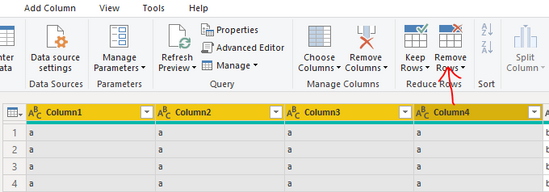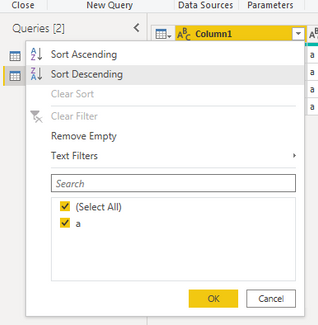FabCon is coming to Atlanta
Join us at FabCon Atlanta from March 16 - 20, 2026, for the ultimate Fabric, Power BI, AI and SQL community-led event. Save $200 with code FABCOMM.
Register now!- Power BI forums
- Get Help with Power BI
- Desktop
- Service
- Report Server
- Power Query
- Mobile Apps
- Developer
- DAX Commands and Tips
- Custom Visuals Development Discussion
- Health and Life Sciences
- Power BI Spanish forums
- Translated Spanish Desktop
- Training and Consulting
- Instructor Led Training
- Dashboard in a Day for Women, by Women
- Galleries
- Data Stories Gallery
- Themes Gallery
- Contests Gallery
- Quick Measures Gallery
- Notebook Gallery
- Translytical Task Flow Gallery
- TMDL Gallery
- R Script Showcase
- Webinars and Video Gallery
- Ideas
- Custom Visuals Ideas (read-only)
- Issues
- Issues
- Events
- Upcoming Events
Calling all Data Engineers! Fabric Data Engineer (Exam DP-700) live sessions are back! Starting October 16th. Sign up.
- Power BI forums
- Forums
- Get Help with Power BI
- Desktop
- Re: BEST APPROACH: Evaluate data in Power Query Ed...
- Subscribe to RSS Feed
- Mark Topic as New
- Mark Topic as Read
- Float this Topic for Current User
- Bookmark
- Subscribe
- Printer Friendly Page
- Mark as New
- Bookmark
- Subscribe
- Mute
- Subscribe to RSS Feed
- Permalink
- Report Inappropriate Content
BEST APPROACH: Evaluate data in Power Query Editor?
Hello,
I'm doing some basic evaluations of a new data table. I wanted to know for how many records 4 columns were equal. Doing this in the Power Query Editor is pretty tough.
I had to:
- Open advanced editor
- Add query to the existing code
#"FilterWhereTimestampsEqual" = Table.SelectRows(tableName, each [column1] = [column2] = [column3] = [column4])
- After doing this, I lost all the history (Query Settings) on the right side(!)
- Because of the preview functionality, I'm only getting 29(?) records at a time.
- I need the total record count!
Questions:
- What is the best way to perform preliminary data evaluation (determine nulls, column redundancy, etc.) in Power BI?
- Should I be using Power Query Editor or another tool within PowerBI?
Thank you
Solved! Go to Solution.
- Mark as New
- Bookmark
- Subscribe
- Mute
- Subscribe to RSS Feed
- Permalink
- Report Inappropriate Content
Hi @ericOnline ,
”What is the best way to perform preliminary data evaluation (determine nulls, column redundancy, etc.) in Power BI?“
You do not need to write M code for preliminary data evaluation, you only need to complete it by using the option feature.
For example, if you want to delete duplicate rows, you can do like this:
(Ctrl + click -> Remove Duplicates)
If you want to remove blank value, you can add filters:
In most cases, we do not need to write M code to complete the data cleaning, and then use DAX for data modeling.
For more information, you can refer to these.
Importing and Cleaning Data with Power Query
Tutorial: Shape and combine data in Power BI Desktop
Best regards,
Lionel Chen
If this post helps, then please consider Accept it as the solution to help the other members find it more quickly.
- Mark as New
- Bookmark
- Subscribe
- Mute
- Subscribe to RSS Feed
- Permalink
- Report Inappropriate Content
Thank you for your insights @v-lionel-msft . I also found that turning on Column Profile and Column Quality helped to evaluate data at-a-glance!
- Mark as New
- Bookmark
- Subscribe
- Mute
- Subscribe to RSS Feed
- Permalink
- Report Inappropriate Content
Hi @ericOnline ,
Has your problem been solved?
Best regards,
Lionel Chen
If this post helps, then please consider Accept it as the solution to help the other members find it more quickly.
- Mark as New
- Bookmark
- Subscribe
- Mute
- Subscribe to RSS Feed
- Permalink
- Report Inappropriate Content
Thank you for your insights @v-lionel-msft . I also found that turning on Column Profile and Column Quality helped to evaluate data at-a-glance!
- Mark as New
- Bookmark
- Subscribe
- Mute
- Subscribe to RSS Feed
- Permalink
- Report Inappropriate Content
Hi @ericOnline ,
”What is the best way to perform preliminary data evaluation (determine nulls, column redundancy, etc.) in Power BI?“
You do not need to write M code for preliminary data evaluation, you only need to complete it by using the option feature.
For example, if you want to delete duplicate rows, you can do like this:
(Ctrl + click -> Remove Duplicates)
If you want to remove blank value, you can add filters:
In most cases, we do not need to write M code to complete the data cleaning, and then use DAX for data modeling.
For more information, you can refer to these.
Importing and Cleaning Data with Power Query
Tutorial: Shape and combine data in Power BI Desktop
Best regards,
Lionel Chen
If this post helps, then please consider Accept it as the solution to help the other members find it more quickly.







